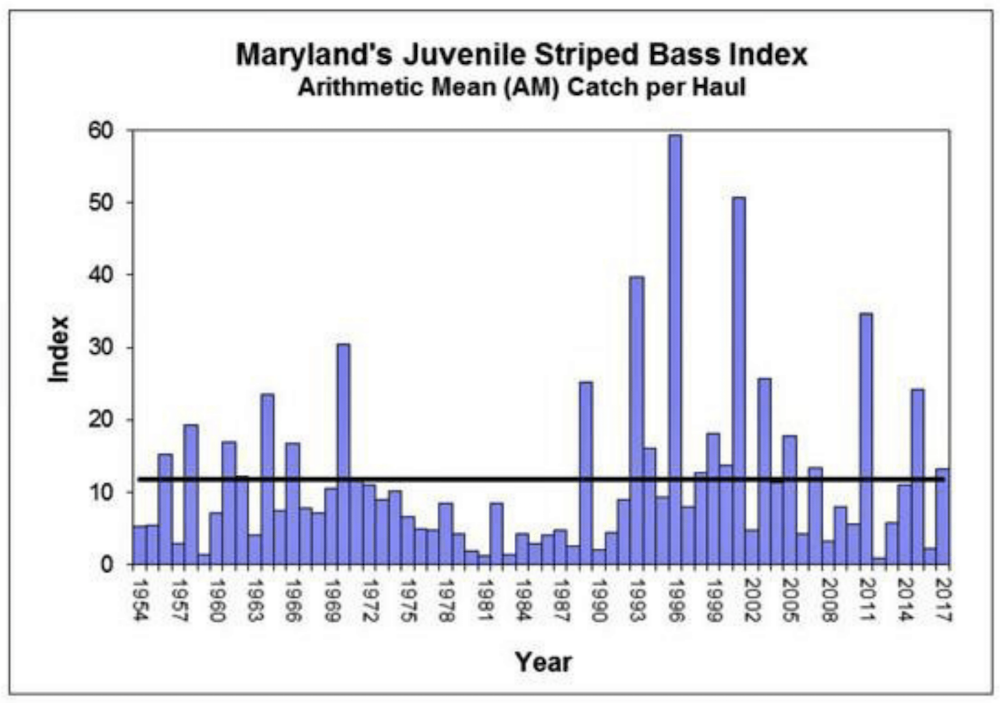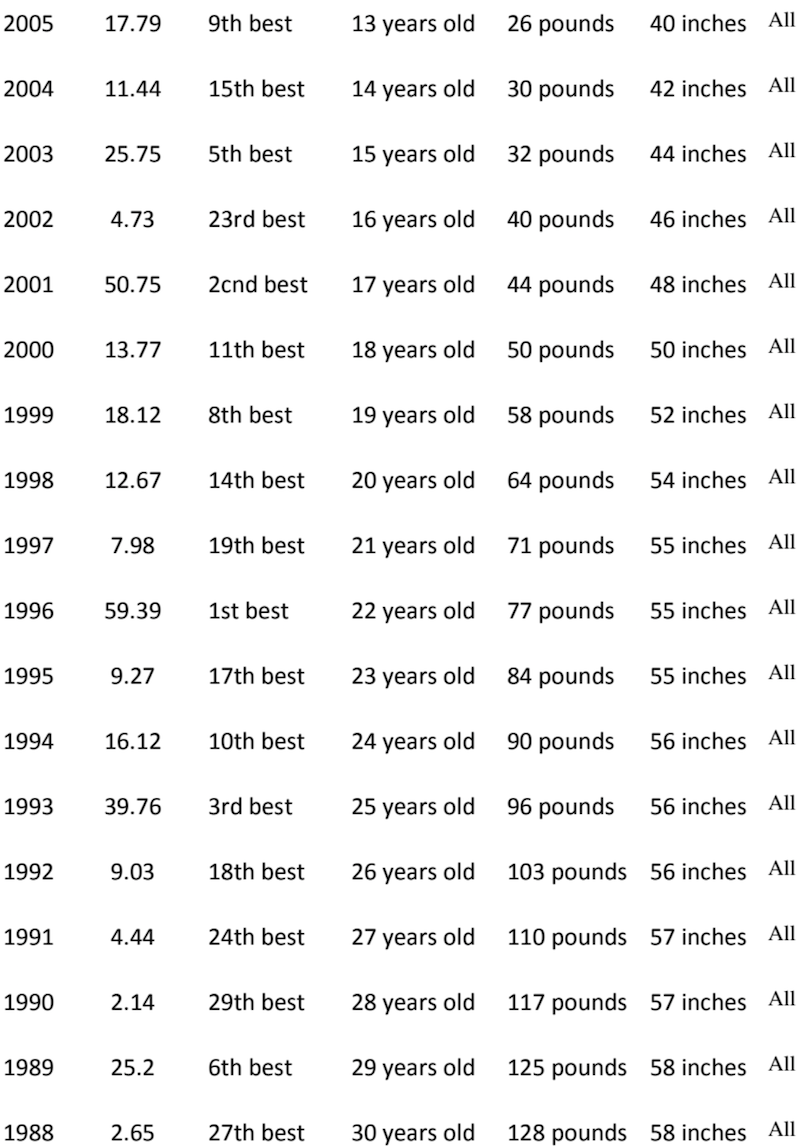The Young of the Year Index has always fascinated me. This is also known as the YOY Index or the Juvenile Striped Bass Index.
The index is the result of an annual survey done by the Maryland DNR to determine the spawning success of Striped Bass in the Chesapeake Bay area.
This survey has been done every year since 1954. Maryland DNR biologists survey 22 sites in the four major spawning systems ─ the Choptank, Nanticoke, and Potomac rivers, as well as the Upper Bay of the Chesapeake.
The crews visit each survey site three times during the summer, collecting fish samples with two sweeps of a 100-foot beach seine.

Photo courtesy of the Maryland Department of Natural Resources
To calculate the indices, biologists count and then average the juvenile fish caught in the samples. They then create the Young of Year Index.

Photo courtesy of the Maryland Department of Natural Resources
When compared to the YOY from prior years, it helps to give an indication of the success or failure of that Spring’s spawning season in the Chesapeake Bay.
Please
login or join MFCC to access
The rest of this article is only available to members of My Fishing Cape Cod.




Kudos for your passion and analysis, Dex. I share your concern and am also concerned about future stocks of our precious resource but look at the striped bass in how it is managed. We bear witness to competing governmental agencies responsible for our entire marine environment. I’ll try to explain:
Your assessment of 32% mortality is missing an explanation of assumptions used, I understood it to be natural and human caused. As I read your post I got the impression all problems with striped bass are human related (harvest and pollution) while citing the success of quotas and moratoriums. I’ll read it again in case I missed your point.
I would opt for a variable mortality factor rather than fixed 32%, for example, the increasing presence and unregulated proliferation of natural predators in the Chesapeake nursery as well as the entire striper range. This has to be considered in the total picture as regulators in other agencies are immersed in this with other priorities, including, but not limited to, 1976 passage of federal law protection of ALL marine mammals, plus their support conservation groups, federal and volounteer, to aid and assist stranded and wounded individuals.
I’ll only mention federally protected species such as seals and cormorants that we are all aware of. They are devastating the resource 24/7/365.
We should include their impact to striped bass and other inshore breeding species such as codfish, another “managed” species as well as their pollution effect to inshore and coastal habitat zones (federal and state agencies).
Keep up the good fight!!
By coincidence I happened on an appropriate article recently published in Canada entitled “Striped bass population triples in Gulf of St. Lawrence”
http://www.cbc.ca/news/canada/nova-scotia/striped-bass-gulf-of-st-lawrence-population-recovery-1.4613759
The concern is recent upsurge in population of stripers are voracious feeders and impacting their salmon catch!! Pests?
This observation also coincides with increased striper fishery in Portland, Maine and points north. This occurrence is not making local news as much as our immediate concerns.
Seems the same fish population is spreading out and resuming its historic range.
I’m sure that increased temperatures of the ocean are having some effect in the Stripers range moving North. I have started seeing articles about how increasing water temps are reducing the catch of lobsters in Maine. I wonder if this is why we seem to be seeing more holdovers in our area, or do we just know people who are really good at catching them?https://myfishingcapecod.com/holdover-striper-feeding-frenzy/#more-44673
Thanks Jack,
It has been shown time and time again that management of one species can not be made in a vacuum. The abundance or decline of any species will effect others who depend on them for food, they are in competition with, or they prey upon. There are numerous examples where either eradication or addition of a species has unintended consequences such as on Macquarie Island which is halfway between Australia and Antarctica. A program to eliminate island cats caused the rabbit population to spiral out of control. The rabbits then nibbled the previously grassy hillsides bare. There is a great video on youtube about the concept called “trophic cascade” and how the introduction of wolves completely changed the environment throughout Yellowstone National Park in a positive way. I highly recommend it. Here is the web address:
https://www.youtube.com/watch?v=ysa5OBhXz-Q
Our local seal population is a serious issue that is getting worse every year and requires a management program but the question is how.
In 1988 the USFWS was worried that the almost 20,000 pairs of Herring Gulls were pushing out other less aggressive birds including Piping Plovers on Monomoy Island. They started a plan of putting poison laced margarine sandwiches into almost 6,000 Herring Gull nests over two days. It turned into a sh*t show. There were wide scale protests and animal activists came onto the island under the cover of night and slipped sandwiches with tuna and charcoal as an antidote into the same nests. I can’t imagine the mess if they started a similar program with 800 pound gray seals.
To your point though, the increased number of seals is already changing the environment as bass are staying offshore and the eastern shore of Cape Cod is becoming a global hot spot for White Sharks.
It was good to meet you at the Mass Bass show.
Hi Dex, You should write a book. Your article is like a college research paper.
Actually Jake, as a part of my Masters Degree in Education I took an ecology course at Framingham State several years ago. My final paper….”The Migration of Striped Bass”.
I enjoyed seeing you yesterday at the Canal cleanup.
Thanks for the insight Dex. I’ve been fishing the canal for 3yrs. Now, and I’ve been practicing catch and release. Every now and then I’ll take a smaller fish home. I agree with you on the smaller fish size. I would even like to see taking of fish only in the 24-28 inch range. No larger no smaller. Just a thought.
Thanks for your efforts, Garry. Hopefully, many from the large 2011 class of 29″ fish will survive for several years to contribute new fish to the biomass.
It looks like the 2018 spawning season may not be very successful due to the continued cold temperatures in the Chesapeake area. I believe the results are usually released in the fall.
Dex,
Thanks for your extremely informative and insightful article.
Hopefully, all members and readers will truly appreciate
the value of this important natural resource, and act
accordingly. I sincerely hope that your position on catch and release
is embraced by more and more people as time goes on, but it
really begins with “NOW”!
Thanks Ron,
As I meet more MFCC members I am struck by how they embrace the complete outdoor experience and value being responsible stewards of this incredible natural resource. As Ryan says, “the important part is being out there, and catching fish is just a bonus”.
Great article Dex! As a fisherman who likes to bring a fish home every now and then, I’m curious what your thoughts are as to the optimal size to keep.
Last season I tried to keep fish in the ~36″ range while letting the bigger ones and the smaller ones go. My reasoning was that 1) the bigger ones are more likely to be female and also bigger ones lay more eggs, and 2) they’ve had at least a couple seasons to spawn.
Is this a reasonable strategy, or would you suggest a different strategy (other than 100% catch-and-release) that might be more optimal for the health of the population as a whole?
I think that your strategy makes a lot of sense, Chris. I would actually like to see a slot limit initiated where only fish in the low 30″ range would be kept.
Dex;
A great blog on the health of our beloved striper.
I want to thank you for such an in depth, understandable, well put together post. I am with you on the releasing fish to preserve fish, understanding that there is a balance needed for those fisherman who make a living from their catch.
Well done, thanks for all the time you put into this website, i for one appreciate it.
I look forward to your next essay?
Dex, A very informative and insightful article. It brings into focus the reasons “why” and hopefully this perspective will be appreciated by the many anglers on MFCC and beyond. As it was said, education is key, as many people probably don’t see this information, so hats off for a fine job.
Thanks Ron,
Seeing the hard data definitely helps you understand what you are seeing out on the water. It brings answers to some questions as you are trying to solve the puzzle. It can also help guide decisions that we make while fishing.
Thank you for your kind words Warren. I enjoy being involved with the MFCC community both through the website and on the beach. Betsy says I am obsessed!